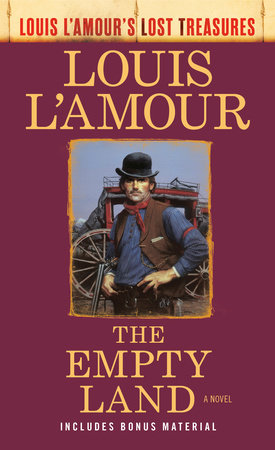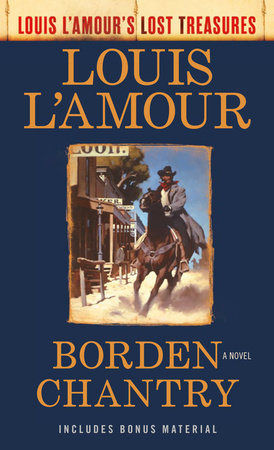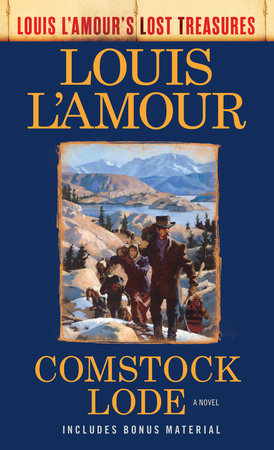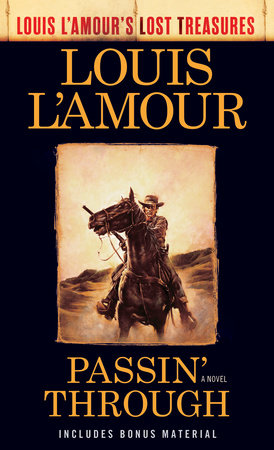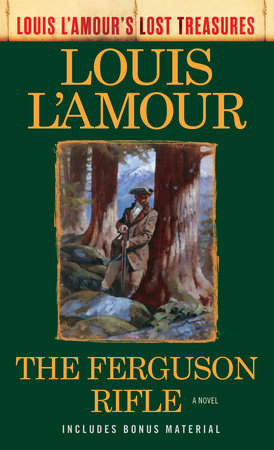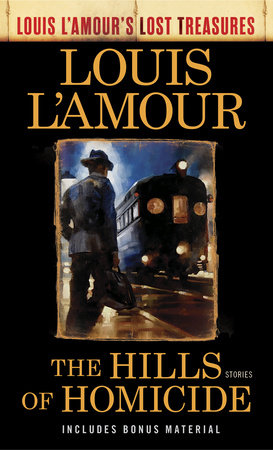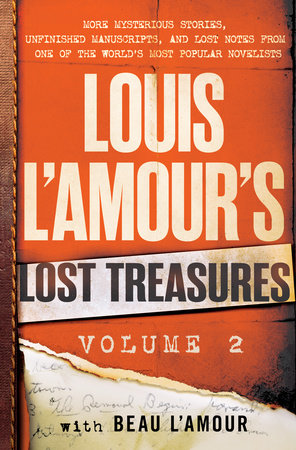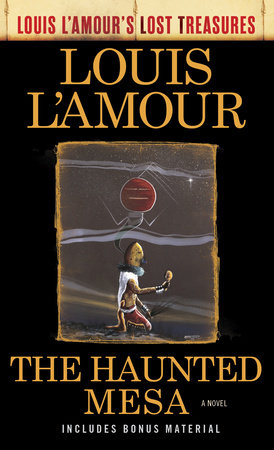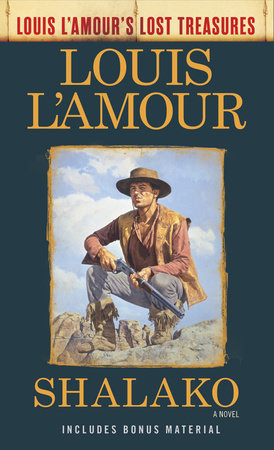Excerpt
The Empty Land (Louis L'Amour's Lost Treasures)
Chapter 1In Europe, Pope Gregory the Great had died, in Ireland the Golden Age of scholarship was at its height, and on the Continent the Merovingian kings ruled much of what is now Germany and France.
In Southeast Asia the little kingdom of Champa, now called South Vietnam, was locked in a life-and-death struggle for its independence, with China and what is now North Vietnam.
It was the seventh century, and the great T’ang dynasty was rising in China, while across the Asian continent a relatively unknown young man named Mohammed sat meditating in Mecca, conceiving the religious teachings that were to dominate civilization for the next seven hundred years.
In what was someday to be known as western Utah, a hungry coyote trotted across a barren slope.
The coyote had no awareness of history beyond the memory of where his food had been obtained in the past, nor had he any realization of the sequence of events he was soon to start in motion, a sequence that was to enrich several men and at least one woman, and was to bring sudden and violent death by bullet or blade to at least forty men.
All of that lay more than eleven hundred years in the future, but it was the coyote that began it.
The desert slope across which the coyote trotted was no different to the eye from a thousand other such slopes, falling steeply away to a boulder-strewn wash that remained dry except after the infrequent rains, when it might run six to eight feet deep with rushing water, only to dwindle away to nothing in an hour or so.
The slope itself was a litter of sand, broken rock, low-growing brush and an occasional juniper.
There was nothing to draw the attention, even less to hold it. There was only the deep green of the junipers against the sand-colored slope, broken here and there by the broken teeth of exposed ledges or outcroppings.
Over the centuries the slope had remained relatively unchanged. A rock rolled here, a cedar sprang up over yonder, a bush died, a passing animal left droppings. The sun and the wind moved over the slope.
The coyote remembered a chipmunk that lived somewhere near the crest. It was a very wily chipmunk, but the coyote was passing his way and might prove luckier than in the past.
Wise in the ways of coyotes, the chipmunk was alert to his coming and, not averse to a little game of tease and tag, waited until the coyote charged, then flipped his tail and ducked into a hole.
Whining with eagerness, the coyote dug at the hole, scattering sand and gravel behind him. Then his claws scraped on rock, uncovering a narrow crack, much too small for a coyote, but perfect for a chipmunk.
Frustrated and furious, the coyote gnawed at the edges of rock, breaking off a few brittle flakes; after that he trotted around behind, searching for another approach, but there was none.
Finally, after much restless pacing and some useless digging, the coyote gave up, deciding the small bite the chipmunk offered was unworthy of so much effort, and he trotted off, pausing only occasionally for a backward glance.
Two months later, it rained. The earth was still loose where the coyote had dug, and the trickle of water off the outcropping came eagerly upon it, filling the hole, then trickling over the edge and starting a tiny stream that hurried down the slope to join the large waters rushing through the wash. The tiny stream carried along with it a small burden of silt and sand, mingled with some minute fragments from the rock, broken off by the teeth of the coyote. When the flash flood ran itself out, the flakes were dropped and left lying to mingle with the sand.
Over the years rains pounded at the slope, and the wind worried it. A juniper seed fell into the crack in the rock, found some slight nourishment, and grew. Water from a late fall rain fell into the crack, a norther froze it, and the expanding ice split the crack still wider. The growing juniper, over the many years, thickened its roots, pushing hard against the rock until it split, and the slab on the downhill side fell, turned over, and lay still.
The inner side of the slab was pressed tightly to the face of the slope. The exposed side, partly covered by the juniper roots, was seamed with bright streaks that ran like jagged lightning through the crumbling quartz.
A hundred years later, another coyote paused in the shade of the juniper, whose boughs now overhung the rock. He nibbled at some of the dry, hard-seeded fruits of the juniper, and rested for a while on the mat of leaves, berries, and shredded bark that had fallen from the tree.
It was in the fall of 1824 that a trapper crossing the arid slope toward the tree-clad mountains beyond the next valley, made a brief pause in the juniper shade. The dribble of water from the rock had widened the coyote-dug hole into a gully that at the top was several feet deep, and deepened steadily as it cut into the slope. This cut offered a shield for the fire he built to make coffee.
Seated over the dying coals, nursing his cup of coffee, he idly sifted some rocks through his fingers. One fragment threw a tiny gleam into his eyes. Turning it in his fingers, he found the small rock was laced with a golden material.
The trapper had never seen gold except in the wedding ring of his mother, but he pocketed the nugget and forgot it when he moved off next morning.
For nineteen years he carried it for a pocket piece, believing it brought him luck. In 1843 he tossed the nugget into a trunk and settled down to running a tavern in a small Missouri town. He married, built a livery stable at the tavern, and forgot the nugget in the trunk. But within its tiny golden heart lay something explosive and violent, something that lay dormant now, but would one day shatter the Nevada-Utah nights with gunfire.
The trapper’s tavern and livery stable brought him affluence, his wife brought him a son. In 1849 he supplied gold-seekers bound for California, but cholera swept the plains and he lost his wife and son.
Through all the years of success and sadness he remembered the land he had seen years before. It lived in his mind, and often with eyes closed he felt again the movement of a good horse, the sound of the wind in the grass or the cedars, the running water, the smell of dust and pines and gunpowder.
He remembered a land unpeopled and still, flecked with cloud shadow. He recalled the great red-walled canyons dotted with the deep green of cedar, or the high ridges golden with autumn’s gift to the aspen. The towering, snowclad hills, the dancing mirage of the desert, the look of a Blackfoot’s chest in the sights of a long Kentucky rifle, these he could not forget.
Finally he sold the tavern and the stable. He was a man growing old, but a man still strong, and a man who knew where his heart was. “You’ll die out there, Jim,” they warned him, and he smiled.
Of course . . . on some dusty slope under the horns of a wounded buffalo or the claws of a grizzly on a mountain trail, or with an arrow in his guts. He might make his final stand on some lonely hill like an old bull, harried by wolves.
“Before I die, boys, I’ll hear the wild geese call beyond the Green. I’ll follow the tracks of elk and bear once more, smell the crushed cedar, and the hay of the wild meadows.”
He emptied his glass and filled it again. “I like it here, but you’ve never seen the sun set over the Teton peaks, or looked across the vast beauty of House Rock Valley from the ridge. I’m sorry to leave you, boys, but I’m a-going back.”
The trapper was camped on the Sweetwater before he mentioned the nugget to anyone. With him were four good men who had come together in the way such men will who have a common purpose, and a common feeling for the same things. They were all together that night, but the one he talked to was young Dick Felton.
Felton was the kind of young man he would have wished his son to be, a strong, fine man of courage and principle, who always did his share of what was to be done, and did not wait to be asked. It was Felton to whom he showed the nugget now.
“No question about it.” Felton was positive, and he knew about such things. “That’s gold. You locate that claim and you will have nothing to worry about.”
The trapper tossed the nugget in his palm. “I will tell you boys where it is, and you can share and share alike. All I want from this country is what it is giving me now.”
“It has been many years,” said Felton. “Are you sure you can remember?”
“For a mountain man it is like walking to the corner store. Once you have been there, you can go back.”
But the trapper did not live to see the place a second time. He was off on the flank of his party looking for game. He found an antelope, and the Utes found him. He got off one shot and went down fighting and calling them names in their own tongue. The warriors knew him, so they did not strip or mutilate the body.
Felton came upon the body when the grass was still fresh with morning, and they buried him on a sunwarmed southern slope with a cedar tree for a marker, and Felton led the way west.
A week later they lost Downey to another Ute raid, but Felton, Cohan, and Zeller went on their way to the trapper’s mountain. They knew what to look for. From the spot where the trapper had picked up the nugget they would be able to look due west to the mountain peak with the glacier. It would be the tallest peak in sight.


